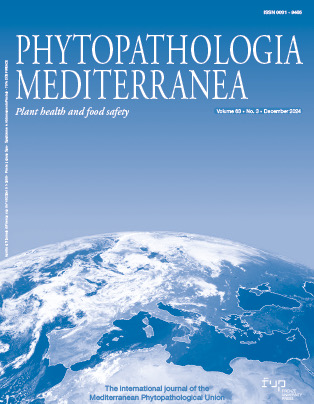Published 2024-12-15
Keywords
- Erysiphaceae,
- morphology,
- molecular analysis,
- taxonomy
How to Cite
Copyright (c) 2024 Zhilong WANG, Wen LI, Yueqiu HE, Feng LIU, Kai FENG, Liang LIU, Tao FU, Qi YE, Guoliang WANG

This work is licensed under a Creative Commons Attribution 4.0 International License.
Abstract
Prunus rufoides is a deciduous wild tree, native to China, which is also used as an ornamental. From late March to December in the years 2018 to 2023, P. rufoides plants growing in Siming Mountain (29°71’08”N, 121°15’12”E), Ningbo, Zhejiang Province, were severely affected by powdery mildew. The disease initially emerged in late March each year, and was characterized as white, irregular mycelial patches on the adaxial surfaces of young leaves. Between July and August, the powdery mildew colonies on affected parts of leaves disappeared, leaving only irregular yellow-brown spots. The disease recurred in September and persisted until late December. Chasmothecia containing asci and ascospores were observed on the leaves in December. Morphological analyses of the chasmothecia indicated a Podosphaera sp. as the causative agent. Molecular identification, based on the internal transcribed spacer (ITS) region (primers ITS4/ITS5) confirmed the identity of the pathogen as Podosphaera prunigena. Koch’s postulates were fulfilled by inoculation tests in which the same pathogen was identified from the inoculated leaf tissue. This study represents the first report confirming the powdery mildew disease on P. rufoides in China to be caused by P. prunigena.
Downloads
References
- Bai L.C., Cao Z.M., Li P.Q., Liang C., 2015. First report of powdery mildew Podosphaera tridactyla on Prunus hypoleuca in China. Plant Disease 99(2): 289. https://doi.org/10.1094/PDIS-09-14-0914-PDN DOI: https://doi.org/10.1094/PDIS-09-14-0914-PDN
- Braun U., Cook R.T.A., 2012. The Taxonomic Manual of the Erysiphales (Powdery Mildews). CBS Biodiversity Series No. 11. CBS-KNAW Fungal Biodiversity Centre, Utrecht, 707.
- Chen Z.X., Yao Y.J., 1989. Podosphaera wuyishanensis Z. X. Acta. Mycologica Sinica 8(4): 256–258. https://doi.org/10.13346/j.mycosystema
- Doyle J., 1991. DNA protocols for plants. In: Molecular Techniques in Taxonomy. Berlin Heidelberg: Springer; 283–293. DOI: https://doi.org/10.1007/978-3-642-83962-7_18
- Farr D.F., Rossman A.Y. U.S., National Fungus Collections, ARS, USDA. Fungal Databases. Available at: https://nt.ars-grin.gov/fungaldatabases/
- Frye C.A., Innes R.W., 1998. An Arabidopsis mutant with enhanced resistance to powdery mildew. Plant Cell 10(6): 947–956. https://doi.org/10.1105/tpc.10.6.947 DOI: https://doi.org/10.1105/tpc.10.6.947
- Hubert J., Fourrier C., Payen C., Fournie J.L., Loos R., 2012. First report of powdery mildew caused by Podosphaera pannosa on Prunus cerasus in France. Plant Disease 96(9): 1375–1375. https://doi.org/10.1094/PDIS-02-12-0218-PDN DOI: https://doi.org/10.1094/PDIS-02-12-0218-PDN
- Kumar S., Stecher G., Tamura K., 2016. MEGA7: Molecular Evolutionary Genetics Analysis version 7.0 for bigger datasets. Molecular Biology and Evolution 33: 1870–1874. https://doi.org/10.1093/molbev/msw054 DOI: https://doi.org/10.1093/molbev/msw054
- Kusaba M., Tsuge T., 1995. Phylogeny of Alternaria fungi known to produce host-specific toxins on the basis of variation in internal transcribed spacers of ribosomal DNA. Current Genetics 28(5): 491–498. https://doi.org/10.1007/BF00310821 DOI: https://doi.org/10.1007/BF00310821
- Larkin M.A., Blackshields G., Brown N.P., Chenna R., McGettigan P.A., Higgins D.G., 2007. ClustalW and ClustalX version 2. Bioinformatics 23: 2947–2948. https://doi.org/10.1093/bioinformatics/btm404 DOI: https://doi.org/10.1093/bioinformatics/btm404
- Lee S., Wen J., 2001. A phylogenetic analysis of Prunus and the Amygdaloideae (Rosaceae) using ITS sequences of nuclear ribosomal DNA. American Journal of Botany 88(1): 150–160. https://doi.org/10.2307/2657135 DOI: https://doi.org/10.2307/2657135
- Li W., He Y.Q., Wang J.Y., Wang G.L., Wang Z.L., 2021. Isolation and identification of pathogen causing anthracnose on Zinnia elegans Jacq. and fungicides screening. Chinese Journal of Pesticide Science 23(2): 341–347. https://doi.org/10.16801/j.issn.1008-7303.2021.0017
- Mabberley D.J., 1997. The Plant-book, a Portable Dictionary of the Vascular Plants. 2nd ed. Cambridge University Press, Cambridge, UK.
- Meeboon J., Takamatsu S., 2015. Erysiphe takamatsui, a powdery mildew of lotus: rediscovery of teleomorph after 40 years, morphology and phylogeny. Mycosphere 56: 159–167. https://doi.org/10.1016/j.myc.2014.05.002 DOI: https://doi.org/10.1016/j.myc.2014.05.002
- Meeboon J., Takamatsu S., Braun U., 2020. Morphophylogenetic analyses revealed that Podosphaera tridactyla constitutes a species complex. Mycologia 112(2): 244–266. https://doi.org/10.1080/00275514.2019.1698924 DOI: https://doi.org/10.1080/00275514.2019.1698924
- Schulze-Lefert P., Vogel J., 2000. Closing the ranks to attack by powdery mildew. Trends in Plant Science 5(8): 343–348. https://doi.org/10.1016/S1360-1385(00)01683-6 DOI: https://doi.org/10.1016/S1360-1385(00)01683-6
- Shirouzu T., Fujita A., Nakamura M., Takamatsu S., 2020. Podosphaera prunigena occurred on leaves of Cerasus kumanoensis and its emended description. Japanese Journal of Mycology 61: 33–39. https://doi.org/10.18962/jjom.jjom.R01-12
- Wang X.R., 2014. An Illustrated Monograph of Cherry Cultivars in China. Beijing, China, Science Press.
- White T.J., Bruns T., Lee S., 1990. PCR Protocols: A Guide to Methods and Applications. Academic Press, San Diego, CA, USA, 315.
- Willis J.C., 1985. A dictionary of the flowering plants and ferns. 8th ed. Cambridge, UK: Cambridge University Press.
- Zhu H., Zhu S.X., Li Y.F., Wang X.R., 2018. Leaf phenotypic variation in natural populations of Cerasus dielsiana. Chinese Journal of Plant Ecology 42(12): 1168–1178. https://doi.org/10.17521/cjpe.2018.0196 DOI: https://doi.org/10.17521/cjpe.2018.0196






